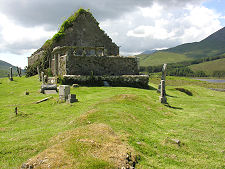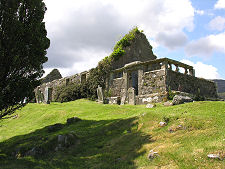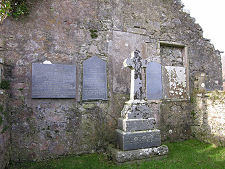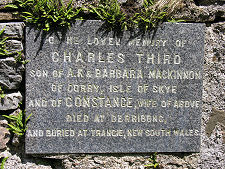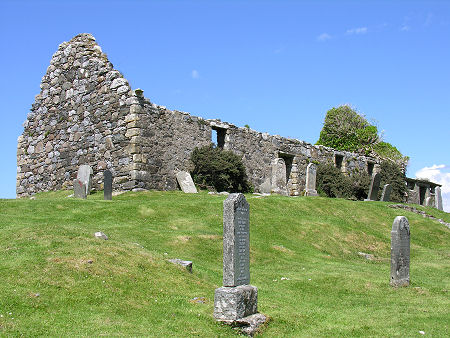 Cill Chriosd from the South |
The broad valley of Strath Suardal provides an easy low-level route that runs south-west from Broadford all the way to Torrin on Loch Slapin. Today the valley is a quiet place, with only a few cottages and farmsteads very thinly scattered along it.
It is difficult to believe today, but for several centuries Strath Suardal was a hive of activity. Skye marble was being extracted from the south side of the valley as early as 1703 when Martin Martin recorded quarries here. In 1907 a railway was built for the 3½ miles from the old pier at Broadford along Strath Suardal to a factory in which high quality marble was dressed and polished. In 1914 the onset of war led to the demise of the operation.
The factory buildings, the workers' houses, the railway line, and most of the company records all disappeared. There was a short-lived attempt to re-establish quarrying here before the World War II, but except for a few remaining scars on the landscape it is almost as if nothing had ever happened here.
And while this activity took place, and as the associated buildings first went up and then came down, it was all quietly observed from a rocky ridge on the north side of the road by the ruins of Cill Chriosd, or Christ's Church. With the road in front of it, the Broadford River behind it, and Loch Cill Chriosd a little to the south-west, Cill Chriosd's elevated position gives it a magnificent location, within an amphitheatre of impressive mountains.
The church's location a heritage of Christian worship that is thought to date back to the 600s, when St Maelrubha preached from the top of a nearby rocky knoll, still called Cnoc na-Aifhreann, or "hill of the mass". The first stone church to appear here probably did so in medieval times, and the church whose ruins stand on top of the ridge today probably replaced that earlier church some time in the 1500s.
There are traces of the earlier church said to be visible in the west gable of the standing ruins, though they are not obvious. The limited available evidence suggests that the earlier church may have been considerably grander than its modest replacement.
Meanwhile, it takes a less expert eye to detect the lines of walls in the ground off to the east of today's ruin, and more accurately aligned east west than the current church. It seems unclear whether these are part of the earlier church.
The first written records relating to the church date back to 1505, though little is known beyond a bare list of the names of the ministers here. In 1627, one Neil MacKinnon was appointed to the post. He is remembered primarily for his meanness and his greed. This was the man who went on record as vowing to report the names of "all the Papists he knew within the Isles“ to the authorities.
He also achieved fame for allowing his workmen only one meal a day on Sundays (compared with two on other days) because they were resting. They retaliated by working on a Sunday. His sermons must have been a real barrel of laughs... Cill Chriosd continued in use until 1840, when it was replaced by a new parish church in Broadford.
Given the ancient heritage of Cill Chriosd you might expect to find traces of very old grave markers. And as recently as 1913 there are records of a pair of unusual stones here. One of these was dedicated to Chief Lachlan Mor and carried "obscure hieroglyphics". The other was thought to date to the pre-Christian era. Both have since disappeared without trace.
Looking at the graves that are on view reveals the area's historical connections with the Clan Mackinnon. Perhaps one of the most interesting is a memorial on the inner wall of the burial enclosure at the north-east end of the church to a man the stonemason appears to have called "Charles Third". He was born in Corry near Broadford as a Mackinnon, before emigrating to Australia, where he died. It has been pointed out to us (by an Australian Mackinnon) that the memorial makes more sense if read as: "Charles, third son of..."
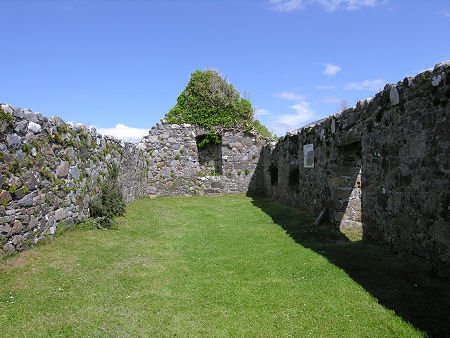 Interior of Cill Chriosd, Looking North-East |

|
|
|
Visitor InformationView Location on MapGrid Ref: NG 617 207 What3Words Location: ///club.reclined.rivals |
 Steps Leading Up From Gateway |
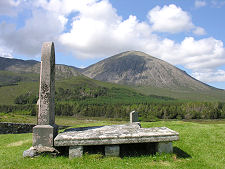 View of Beinn na Caillich |
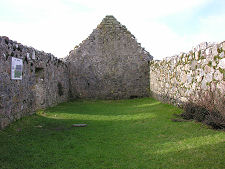 Interior, Looking South-West |
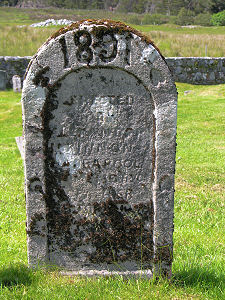 Gravestone Dated 1891 |
